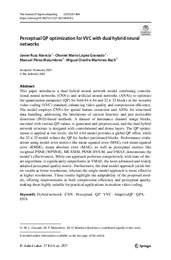Título :
Perceptual QP optimization for VVC with dual hybrid neural
networks |
Autor :
Ruiz Atencia, Javier
Lopez Granado, Otoniel
Pérez Malumbres, Manuel
Martínez-Rach, Miguel |
Editor :
Springer |
Departamento:
Departamentos de la UMH::Ingeniería de Computadores |
Fecha de publicación:
2025 |
URI :
https://hdl.handle.net/11000/36863 |
Resumen :
This paper introduces a dual hybrid neural network model combining convolu-
tional neural networks (CNNs) and artificial neural networks (ANNs) to optimize
the quantization parameter (QP) for both 64 × 64 and 32 × 32 blocks in the versatile
video coding (VVC) standard, enhancing video quality and compression efficiency.
The model employs CNNs for spatial feature extraction and ANNs for structured
data handling, addressing the limitations of current heuristic and just noticeable
distortion (JND)-based methods. A dataset of luminance channel image blocks,
encoded with various QP values, is generated and preprocessed, and the dual hybrid
network structure is designed with convolutional and dense layers. The QP optimi-
zation is applied at two levels: the 64 × 64 model provides a global QP offset, while
the 32 × 32 model refines the QP for further partitioned blocks. Performance evalu-
ations using model error metrics like mean squared error (MSE), root mean squared
error (RMSE), mean absolute error (MAE), as well as perceptual metrics like
weighted PSNR (WPSNR), MS-SSIM, PSNR-HVS-M, and VMAF, demonstrate the
model’s effectiveness. While our approach performs competitively with state-of-the-
art algorithms, it significantly outperforms in VMAF, the most advanced and widely
adopted perceptual quality metric. Furthermore, the dual-model approach yields bet-
ter results at lower resolutions, whereas the single-model approach is more effective
at higher resolutions. These results highlight the adaptability of the proposed mod-
els, offering improvements in both compression efficiency and perceptual quality,
making them highly suitable for practical applications in modern video coding.
|
Palabras clave/Materias:
Hybrid network
CNN
Perceptual
QP
VVC
AdaptiveQP
QPA
HVS |
Área de conocimiento :
CDU: Ciencias aplicadas: Ingeniería. Tecnología |
Tipo de documento :
info:eu-repo/semantics/article |
Derechos de acceso:
info:eu-repo/semantics/openAccess
Attribution-NonCommercial-NoDerivatives 4.0 Internacional |
DOI :
https://doi.org/10.1007/s11227-025-06954-z |
Publicado en:
The Journal of Supercomputing (2025) 81:464 |
Aparece en las colecciones:
Artículos Ingeniería de computadores
|

 La licencia se describe como: Atribución-NonComercial-NoDerivada 4.0 Internacional.
La licencia se describe como: Atribución-NonComercial-NoDerivada 4.0 Internacional.
.png)